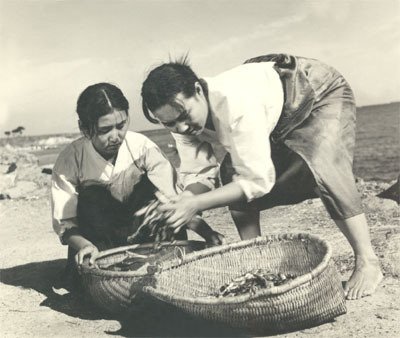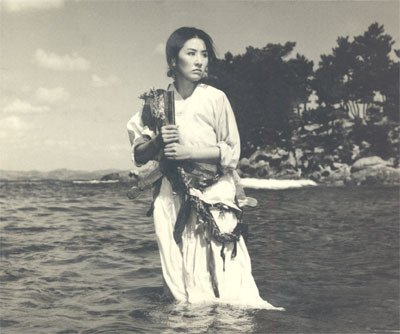Life by the seaside on a remote island community is richly explored through the women’s perspective in director Kim Soo-yong’s 1965 classic “The Seashore Village”. The film, based on a novel and noted by legendary director Bae Chang-ho as being among his most favourite Korean films of all time, was selected as the Best Film at the Grand Bell Awards upon release.
“The Seashore Village” is screening at Ulju Mountain Film Festival 2019

On a quiet island by the East Sea, there exists a small seashore village whose inhabitants have lived there for several generations. The men go out to sea to fish while the women stay back to tend to the village and do the chores around the island. One such fishing trip is ravaged by a storm, which leads to the beautiful newlywed Hae-soon losing her husband at sea. The new widow joins the group of other island widows as she goes about doing her chores and diving into the sea to catch shellfish and such, aware of but ignoring the fact that she has caught the eye of Sang-soo, a young coal miner who lives on the island presently. Goaded by the teasing and taunts of the other widows, Hae-soon gives into her desire and sleeps with Sang-soo, which becomes hot gossip among the villagers. When her brother-in-law and mother-in-law hear about this, they decide to send Hae-soon away with Sang-soo for her happiness. But fate, as it turns out, is not nearly done tampering with Hae-soon’s life yet.
Kim Soo-yong’s film succeeds on many levels. Its depiction of a remote community thriving on a particular livelihood, to include their love, loss, trials and tribulations is excellent, almost documentary-like. Most interestingly, the film focuses completely on the women’s perspective for the most part. In a place where there are little rules and ample freedom for the women, specially the widowed ones, the effects that this freedom has on their lives, both good and bad, are portrayed. Loneliness is another key theme that the film explores. All the character live within the otherwise tight community, but each carries within themselves an island of loneliness. The widows are all lonely, yet smile through their loneliness and persevere through. Some smile and laugh through their pains, some take up relations with other women while Hae-soon gives in to her desire to love and be loved by giving into Sang-soo’s efforts to woo her. Inversely, Soon-im, a pregnant lady who also lost her husband to the same storm, cannot stop the grief and loneliness from engulfing her in the worst way possible.

As the film goes on, the concept of belonging, to a place, a lifestyle or a particular people, is delved into. The islanders cannot even think about leaving the island, their seashore lifestyle and their cultural ways, even for the better. This is highlighted in a longing conversation between the mother-in-law and her surviving younger son after the departure of Hae-soon. Hae-soon, meanwhile, though seemingly happy with her loved one in a new life, cannot seem to stop missing the sound of the waves, the smell of the fish and the joy that even her mundane chores brought her, as long as she was with her people. The small scene in which she climbs higher and higher on a mountain in hopes of catching a tiny glimpse of the sea over the mountains is masterful.
In Shin Young-hyun, as the carefree Sang-soo, and Ko Eun-ah, as the beautiful Hae-soon, whose beauty brings more problems than happiness for her, Kim Soo-yong has two excellent actors who carry the film through wonderfully. Ko Eun-ah’s Hae-soo is our window into this world and the actress is particularly successfully in making the audience empathise with the character while also marvelling at her beauty. In a sea of able supporting actresses, Hwang Jung-soon stands out as the understanding and loving mother-in-law of Hae-soon, embodying the turmoil that comes with having to choose between the judging eye of the community and her daughter-in-law’s happiness while dealing with her sorrow over her elder son’s demise.

Jeon Jo-myeong’s cinematography is a highlight, adding to the documentary-like realism of the film. It ably captures the beauty of the seashore village, the mountains as well as the few staged sets. Some of the wide-angle shots of the sea and the mountains are particularly fetching. Yu Jae-won’s editing keeps the film progressing at a fast pace, never feeling disjointed or rushed in its 93-minute runtime.
In a filmography that spans nearly half a century, “The Seashore Village” remains one of Kim Soo-yong’s finest and most successful features. A film fully deserving of both the “classic” and “masterpiece” monikers bestowed upon it, it should be essential viewing for someone with an interest in Korean cinema. It would, however, be interesting to see how certain elements of the film are perceived and received in the post-#metoo world today, specifically Sang-soo’s pursuit of Hae-soon’s affection.